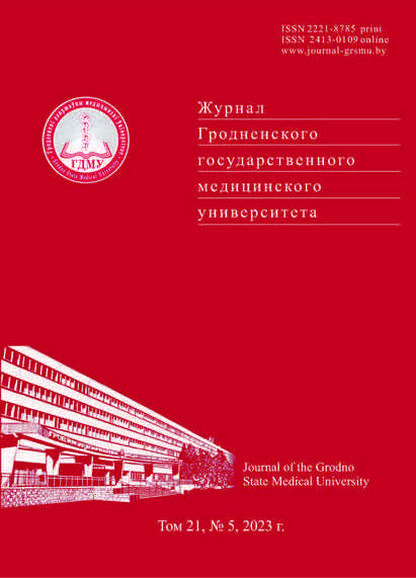СТРАТИФИКАЦИЯ РИСКА ПРОГРЕССИРОВАНИЯ ФИБРИЛЛЯЦИИ ПРЕДСЕРДИЙ
Аннотация
Пароксизмальная форма фибрилляции предсердий со временем может прогрессировать до устойчивых форм, что связано с повышенным риском неблагоприятных событий и исходов. Использование инструментов прогнозирования прогрессирования аритмии может быть полезным для выявления пациентов высокого риска. В обзоре рассмотрены восемь шкал стратификации риска прогрессирования фибрилляции предсердий, а также проведен их сравнительный анализ. Описаны основные факторы риска рецидива аритмии и перехода ее в постоянную форму. По результатам проведенной работы установлено, что данные шкалы характеризуются разнородностью оцениваемых переменных, что диктует необходимость создания новых инструментов для диагностики.
Литература
Heijman J, Luermans JGLM, Linz D, van Gelder IC, Crijns HJGM. Risk Factors for Atrial Fibrillation Progression. Card Electrophysiol Clin. 2021;13(1):201-209. https://doi.org/10.1016/j.ccep.2020.10.011.
Kisheva A, Yotov Y. Risk factors for recurrence of atrial fibrillation. Anatol J Cardiol. 2021;25(5):338-345. https://doi.org/10.14744/AnatolJCardiol.2020.80914.
Truong CD, Nguyen BT, Van Cong Tran T. Prediction of risk factors for recurrence of atrial fibrillation in patients with arterial hypertension. Int J Cardiovasc Imaging. 2021;37(12):3413-3421. https://doi.org/10.1007/s10554-021-02331-y.
Kamioka M, Hijioka N, Matsumoto Y, Nodera M, Kaneshiro T, Suzuki H, Takeishi Y. Uncontrolled blood pressure affects atrial remodeling and adverse clinical outcome in paroxysmal atrial fibrillation. Pacing Clin Electrophysiol. 2018;41(4):402-410. https://doi.org/10.1111/pace.13311.
Vos CB, Pisters R, Nieuwlaat R, Prins MH, Tieleman RG, Coelen RJ, Heijkant AC, Allessie MA, Crijns HJ. Progression from paroxysmal to persistent atrial fibril-lation clinical correlates and prognosis. J Am Coll Cardiol. 2010;55(8):725-31. https://doi.org/10.1016/j.jacc.2009.11.040.
Emren SV, Kocabaş U, Duygu H, Levent F, Şimşek EÇ, Emren ZY, Tülüce S. The role of HATCH score in predicting the success rate of sinus rhythm following electrical cardioversion of atrial fibrillation. Kardiol Pol. 2016;74(9):978-84. https://doi.org/10.5603/KP.a2016.0044.
Tang R, Dong J, Long D, Yu R, Ning M, Jiang C, Sang C, Liu X, Ma C. Efficacy of catheter ablation of atrial fibrillation beyond HATCH score. Chin Med J. 2012;125(19):3425-9.
Miao D, Zang X, Zhang S, Gao L, Xia Y, Yin X, Chang D, Dong Y, Yang Y. Predictive value of HATCH score on atrial fibrillation recurrence post radiofrequency catheter ablation. Zhonghua Xin Xue Guan Bing Za Zhi. 2012;40(10):821-4.
Schmidt EU, Schneider R, Lauschke J, Wendig I, Bänsch D. The HATCH and CHA2DS 2-VASc scores. Prognostic value in pulmonary vein isolation. Herz. 2014;39(3):343-8. https://doi.org/10.1007/s00059-013-3835-x.
Letsas KP, Efremidis M, Giannopoulos G, Deftereos S, Lioni L, Korantzopoulos P, Vlachos K, Xydonas S, Kossyvakis C, Sideris A. CHADS2 and CHA2DS2-VASc scores as predictors of left atrial ablation outcomes for paroxysmal atrial fibrillation. Europace. 2014;16(2):202-7. https://doi.org/10.1093/europace/eut210.
Kornej J, Hindricks G, Shoemaker MB, Husser D, Arya A, Sommer P, Rolf S, Saavedra P, Kanagasundram A, Whalen P, Montgomery J, Ellis CR, Darbar D, Bollmann A. The APPLE score: a novel and simple score for the prediction of rhythm outcomes after catheter ablation of atrial fibrillation. Clin Res Cardiol. 2015;104(10):871-876. https://doi.org/10.1007/s00392-015-0856-x.
Canpolat U, Aytemir K, Yorgun H, Şahiner L, Kaya EB, Oto A. A proposal for a new scoring system in the prediction of catheter ablation outcomes: promising results from the Turkish Cryoablation Registry. Int J Cardiol. 2013;169(3):201-206. https://doi.org/10.1016/j.ijcard.2013.08.097.
Mesquita J, Ferreira AM, Cavaco D, Costa FM, Carmo P, Marques H, Morgado F, Mendes M, Adragão P. Development and validation of a risk score for predicting atrial fibrillation recurrence after a first catheter ablation procedure - ATLAS score. Europace. 2018;20(FI 3):f428-f435. https://doi.org/10.1093/europace/eux265.
Mujović N, Marinković M, Marković N, Shantsila A, Lip GY, Potpara TS. Prediction of very late arrhythmia recurrence after radiofrequency catheter ablation of atrial fibrillation: The MB-LATER clinical score. Sci Rep. 2017;7:40828. https://doi.org/10.1038/srep40828.
Furui K, Morishima I, Morita Y, Kanzaki Y, Takagi K, Yoshida R, Nagai H, Watanabe N, Yoshioka N, Yamauchi R, Tsuboi H, Murohara T. Predicting long-term freedom from atrial fibrillation after catheter ablation by a machine learning algorithm: Validation of the CAAP-AF score. J Arrhythm. 2020;36(2):297-303. https://doi.org/10.1002/joa3.12303.
Kosiuk J, Dinov B, Kornej J, Acou W, Schönbauer R, Fiedler L, Buchta P, Myrda K, Gąsior M, Poloński L, Kircher S, Arya A, Sommer P, Bollmann A, Hindricks G, Rolf S. Prospective, multicenter validation of a clinical risk score for left atrial arrhythmogenic substrate based on voltage analysis: DR-FLASH score. Heart Rhythm. 2015;12(11):2207-12. https://doi.org/10.1016/j.hrthm.2015.07.003.
Yang W, Du X, Fawzy A, He L, Li H, Dong J, Lip G, Ma C. Associations of atrial fibrillation progression with clinical risk factors and clinical prognosis: A report from the Chinese Atrial Fibrillation Registry study. J Cardiovasc Electrophysiol. 2021;32(2):333-341. https://doi.org/10.1111/jce.14826.
Kerr C, Humphries K, Talajic M, Klein G, Connolly S, Green M, Boone J, Sheldon R, Dorian P, Newman D. Progression to chronic atrial fibrillation after the initial diagnosis of paroxysmal atrial fibrillation: results from the Canadian Registry of Atrial Fibrillation. Am Heart J. 2005;149(3):489-96. https://doi.org/10.1016/j.ahj.2004.09.053.
Li A, Chen Y, Wang W, Su L, Ling Z. Association of clinical predictors with recurrence of atrial fibrillation after catheter ablation. Ann Noninvasive Electrocardiol. 2020;25(6):e12787. https://doi.org/10.1111/anec.12787.
Kinoshita M, Herges R, Hodge D, Friedman L, Ammash N, Bruce C, Somers V, Malouf J, Askelin J, Gilles J, Gersh B, Friedman P. Role of smoking in the recurrence of atrial arrhythmias after cardioversion. Am J Cardiol. 2009;104(5):678-682. https://doi.org/10.1016/j.amjcard.2009.04.041.
Fukamizu S, Sakurada H, Takano M, Hoj R, Nakai M, Yuba T, Komiyama K, Tatsumoto A, Maeno K, Mizusawa Y, Tanab Y, Suzuki M, Tejima T, Nishizaki M, Kobayashi Y, Hiraoka M. Effect of cigarette smoking on the risk of atrial fibrillation recurrence after pulmonary vein isolation. J Arrhythm. 2010;26(1):21-29. https://doi.org/10.1016/S1880-4276(10)80032-8.
Tsang T, Barnes M, Miyasaka Y, Cha S, Bailey K, Verzosa G, Seward J, Gersh B. Obesity as a risk factor for the progression of paroxysmal to permanent atrial fibrillation: a longitudinal cohort study of 21 years. Eur Heart J. 2008;29(18):2227-33. https://doi.org/10.1093/eurheartj/ehn324.
Hidirova LD, Jahontov DA, Zenin SA, Maksimov VN. Nekotorye fenotipicheskie i geneticheskie markery progressirovanija fibrilljacii predserdij na fone arterialnoj gipertonii. Eurasian Heart Journal. 2019;(S2):241-242. edn: OQFMDA. (Russian).
Podzolkov VL, Tarzimanova AL, Gataulin RG. The clinical course of atrial fibrillation in patients with coronary heart disease. Clinical Medicine. 2016;94(8):591-595. https://doi.org/10.18821/0023-2149-2016-94-8-591-595. https://www.elibrary.ru/vwzxan. (Russian).
Zhao LQ, Liu SW. Atrial fibrillation in essential hypertension: an issue of concern. J Cardiovasc Med. 2014;15(2):100-106. https://doi.org/10.2459/JCM.0b013e3283640ff7.
Larina VN, Skiba IK, Skiba AS, Larin VG, Vartanyan EA. Heart failure and atrial fibrillation: updates and perspectives. Rus J Cardiol. 2022;27(7):183-190. https://doi.org/10.15829/1560-4071-2022-5018. https://www.elibrary.ru/zinuka. (Russian).
Podzolkov VI, Tarzimanova AI. Current Predictors of Atrial Fibrillation Progression. Rational Pharmacotherapy in Cardiology. 2019;15(2):149-158. https://doi.org/10.20996/1819-6446-2019-15-2-149-158. https://www.elibrary.ru/cqfxik.
Suzuki T, Yamazaki T, Ogawa S, Nagai R, Yamashita T. Echocardiographic predictors of frequency of paroxysmal atrial fibrillation (AF) and its progression to persistent AF in hypertensive patients with paroxysmal AF: results from the Japanese Rhythm Management Trial II for Atrial Fibrillation (J-RHYTHM II Study). Heart Rhythm. 2011;8(12):1831-6. https://doi.org/10.1016/j.hrthm.2011.07.035.
Podzolkov VI, Tarzimanova AI. Predictors of progression of atrial fibrillation in patients with arterial hypertension. Systemic Hypertension. 2016;13(1):11-14. edn: VWZXAN. (Russian).
Snezhitsky VA, Yatskevich ES, Doroshenko EM, Smirnov VY, Dolgoshey TS, Rubinsky AY. Homocysteine as a prognostic marker of atrial remodeling and clinical picture in patients with paroxysmal and persistent forms of atrial fibrillation. Clinical medicine. 2016;94(1):16-22. https://doi.org/10.18821/0023-2149-2016-94-1-16-22. https://www.elibrary.ru/vkyatz. (Russian).
De With RR, Marcos EG, EAMP D, Spronk HM, Crijns HJGM, Rienstra M, Van Gelder IC. Atrial fibrillation progression risk factors and associated cardiovascular outcome in well-phenotyped patients: data from the AF-RISK study. Europace. 2020;22(3):352-360. https://doi.org/10.1093/europace/euz339.
Simons SO, Elliott A, Sastry M, Hendriks JM, Arzt M, Rienstra M, Kalman, Heidbuchel H, Nattel S, Wesseling G, Schotten U, Van Gelder IC, Franssen FME, Sanders P, Crijns HJGM, Linz D. Chronic obstructive pulmonary disease and atrial fibrillation: an interdisciplinary perspective. Eur Heart J. 2021;42(5):532-540. https://doi.org/10.1093/eurheartj/ehaa822.
Adasheva TV, Pavlov SV, Leonova EI, Samorukova EI, Zadionchenko VS. Prognosticheskaja model razvitija fibrilljacii predserdij u bolnyh hronicheskoj obstruktivnoj boleznju legkih. CardioSomatics. 2017;8(1):6. https://doi.org/10.26442/CS45230. (Russian).
Cho SW, Hwang JK, Chun KJ, Park S, Park K, Kim JS, On YK. Impact of moderate to severe renal impairment on long-term clinical outcomes in patients with atrial fibrillation. J Cardiol. 2017;69(3):577-583. https://doi.org/10.1016/j.jjcc.2016.04.006.
Takahashi Y, Takahashi A, Kuwahara T, Okubo K, Fujino T, Takagi K, Nakashima E, Kamiishi T, Hikita H, Hirao K, Isobe M. Renal function after catheter ablation of atrial fibrillation. Circulation. 2011;124(22):2380-7. https://doi.org/10.1161/CIRCULATIONAHA.111.047266.
Li Z, Wang S, H Hidru T, Sun Y, Gao L, Yang X, Xia Y. Long Atrial Fibrillation Duration and Early Recurrence Are Reliable Predictors of Late Recurrence After Radiofrequency Catheter Ablation. Front Cardiovasc Med. 2022;9:864417. https://doi.org/10.3389/fcvm.2022.864417.
Mulder MJ, Kemme MJB, Hopman LHGA, Kuşgözoğlu E,Gülçiçek H, Ven PM, Hauer HA, Tahapary GJM, Götte MJW, Rossum AC, Allaart CP. Comparison of the predictive value of ten risk scores for outcomes of atrial fibrillation patients undergoing radiofrequency pulmonary vein isolation. Int J Cardiol. 2021;344:103-110. https://doi.org/10.1016/j.ijcard.2021.09.029.
Deng H, Bai Y, Shantsila A, Fauchier L, Potpara TS, Lip GYH. Clinical scores for outcomes of rhythm control or arrhythmia progression in patients with atrial fibrillation: a systematic review. Clin Res Cardiol. 2017;106(10):813-823. https://doi.org/10.1007/s00392-017-1123-0.





























